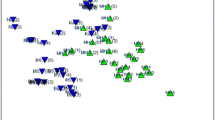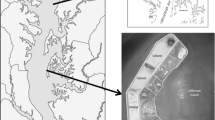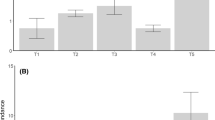Abstract
In the 1970s, acid sulfate soils (ASS) distributed within about 720 ha of predominantly mangrove and salt pan wetlands at East Trinity in north Queensland were developed after the area was isolated from tidal flooding by a surrounding seawall and the installation of tidal gates on major drainage creeks. Following drainage and oxidation of these estuarine acidic sediments, resultant acid leachate caused considerable, ongoing environmental problems including regular fish kills. A rehabilitation program covering much of these former tidal wetlands commenced in 2000 using a lime-assisted tidal exchange management regime. Changes in the established populations of estuarine fish and crustaceans were monitored in the two creeks (Firewood and Hills Creeks) where tidal flows were reinstated. In Firewood Creek between 2001 and 2005, there was a progressive increase in fish species richness, diversity and abundance. The penaeid prawn Fenneropenaeus merguiensis was a major component of the cast net catches in the lower sections of both Firewood and Hills Creeks but its relative abundance decreased upstream of the tidal gates on the seawall. Well established stocks of predominantly juvenile, male Scylla serrata resident upstream of the tidal gates indicated suitable habitats with acceptable water and sediment quality and adequate availability of food. The regular fish kills that occurred prior to the management regime abated and, overall, the implementation of the rehabilitation program is yielding positive benefits for the local fisheries.





Similar content being viewed by others
References
Australian Soil Science Information System (2006) Maps. CSIRO. http://www.asris.csiro.au. Accessed 11 March 2010
Beumer J (1978) Feeding ecology of four fishes from a mangrove creek in north Queensland, Australia. J Fish Biol 12:475–490
Bowman G, Hicks W, Fitzpatrick R, Davies PM (1999) Remediation options for the acid sulfate soil “hotspot” at east Trinity Inlet, Cairns, North Queensland. In: ASSMAC workshop on remediation and assessment of broadacre acid sulfate soils, Lismore, New South Wales
Bush RT, Fyfe D, Sullivan LA (2004a) Occurrence and abundance of monosulfidic black ooze in coastal acid sulfate soil landscapes. Aust J Soil Res 42(5–6):609–616
Bush RT, Sullivan LA, Fyfe D, Johnston S (2004b) Redistribution of monosulfidic black oozes by floodwaters in a coastal acid sulfate soil floodplain. Aust J Soil Res 42(5–6):603–607
Callinan RB, Paclibare JO, Reantaso MB, Lumanlan-Mayo SC, Fraser GC, Sammut J (1995) EUS outbreaks in estuarine fish in Australia and the Philippines: associations with acid sulphate soils, rainfall, and Aphanomyces. In: Shariff M, Arthur JR, Subasinghe RP (eds) Diseases in Asian aquaculture II. Fish Health Section, Asian Fisheries Society, Manila, pp 291–298
Cook FJ, Hicks W, Gardner EA, Carlin GD, Froggatt DW (2000) Export of acidity in drainage water from acid sulphate soils. Mar Pollut Bull 41(7–12):319–326
Driscoll CT, Baker JP, Bisogni JJ, Schofield CL (1980) Effect of aluminium speciation on fish in dilute acidified waters. Nature 284:161–164
Graham M, Grimshaw J, Hegerl E, McNalty J, Timmins R (1975) Cairns wetlands—a preliminary report. Operculum 4(3):116–148
Hicks WS, Bowman GM, Fitzpatrick RW (1999) East Trinity acid sulphate soils. Part 1: Environmental hazards. CSIRO Land and Water, Report 14/99, Adelaide, South Australia
Hicks W, Bowman GM, Fitzpatrick R (2002) The geochemistry of Australian tropical acid sulfate soils and their environmental hazard. In: 17th World congress of soil science, 14–21 August 2002. Book of abstracts. International Union of Soil Science, Bangkok, p 1897
Hicks WS, Bowman GM, Fitzpatrick RW (2009) Effect of season and landscape position on the aluminium geochemistry of tropical acid sulfate soil leachate. Aust J Soil Res 47(2):137–153. doi:10.1071/SR06106
Johnston SG et al (2009) Changes in water quality following tidal inundation of coastal lowland acid sulfate soil landscapes. Estuar Coast Shelf Sci 81(2):257–266
Johnston SG et al (2010) Arsenic mobilization in a seawater inundated acid sulfate soil. Environ Sci Technol 44(6):1968–1973. doi:10.1021/es903114z
Kroon FJ (2005) Behavioural avoidance of acidified water by juveniles of four commercial fish and prawn species with migratory life stages. Mar Ecol Prog Ser 285:193–204
Kroon FJ, Ansell DH (2006) A comparison of species assemblages between drainage systems with and without floodgates: implications for coastal floodplain management. Can J Fish Aquat Sci 63(11):2400–2417. doi:10.1139/F06-134
Kroon FJ, Bruce AM, Housefield GP, Creese RG (2004) Coastal floodplain management in eastern Australia: barriers to fish and invertebrate recruitment in acid sulphate soil catchments. New South Wales Department of Primary Industries—Fisheries, Nelson Bay
Lee CP (1979) Life cycle of the wild mud crab (Scylla serrata). Fish News (QLD) (June): 8–9, 12
Manson FJ, Loneragan NR, Harch BD, Skilleter GA, Williams L (2005) A broad-scale analysis of links between coastal fisheries production and mangrove extent: a case-study for northeastern Australia. Fish Res 74(1–3):69–85
McDonald DG (1983) The effects of H+ upon the gills of freshwater fish. Can J Zool 61(4):691–703. doi:10.1139/z83-093
Olsen HF (1983) Biological resources of Trinity Inlet and Bay. Queensland Department of Primary Industries, Brisbane
Powell B, Ahern CR (1999) Nature, origin and distribution of acid sulphate soils: issues for Queensland. In: Hey KM, Ahern CR, Eldershaw VJ, Anrov JM, Watling KM (eds) Acids sulphate soils and their management in coastal Queensland, forum and technical course. Department of Natural Resources, Indooroopilly, pp 1.1–1.11
Powell B, Martens M (2005) A review of acid sulfate soil impacts, actions and policies that impact on water quality in Great Barrier Reef catchments, including a case study on remediation at East Trinity. Mar Pollut Bull 51(1–4):149–164
Preda M, Cox ME (1998) Sediment–water interaction, acidity and other waste quality parameters in a subtropical setting, Pimpama River, southeast Queensland. Environ Geol 39(3–4):319–329
Roach AC (1997) The effect of acid water inflow on estuarine benthic and fish communities in the Richmond River, N.S.W. Australia. Aust J Ecotoxicol 3(1):25–56
Robertson AI, Duke NC (1987) Mangroves as nursery sites: comparisons of the abundance and species composition of fish and crustaceans in mangroves and other nearshore habitats in tropical Australia. Mar Biol 96:193–205
Russell DJ (1980) Commercial fishes of Trinity Inlet. Queensland Department of Primary Industries, Brisbane
Russell DJ (2006) Remediation of acid sulfate soils at east Trinity, north Queensland: effects on fisheries and water quality. In: Catchments to coast. Australian Marine Sciences Association 44th annual conference and the Society of Wetland Scientists 27th international conference, Cairns, 9–14 July 2006. Australian Marine Sciences Association and the Society of Wetland Scientists, Cairns, p 102
Russell DJ, Helmke SA (2002) Impacts of acid leachate on water quality and fisheries resources of a tidal creek in northern Australia. Mar Freshw Res 53:19–33
Russell DJ, McDougall AJ (2003) Biota and stream water quality monitoring. In: Smith CD et al (eds) Demonstration of management and rehabilitation of acid sulfate soils at east Trinity. Queensland Department of Natural Resources and Mines, Brisbane
Russell DJ, Preston KM (2005) Effects of acid sulfate soils remediation on aquatic ecology and water quality at east Trinity, north Queensland. Department of Primary Industries and Fisheries, QI05060, Cairns
Russell DJ, Smith CD, Best EK, Helmke SA, Hales PW (1996) Water quality trends from an acid sulfate soil source, Cairns, north Queensland. In: Smith RJ, Smith HJ (eds) Proceedings of the 2nd national conference of acid sulfate soils held at Coffs Harbour, 5–6 September 1996. Robert J. Smith and Associates, pp 161–162
Sammut J, White I, Melville MD (1994) Stratification in acidified coastal floodplain drains. Wetlands 13:49–64
Sammut J, Melville MD, Callinan RB, Fraser GC (1995) Estuarine acidification: impacts on aquatic biota of draining acid sulphate soils. Aust Geogr Stud 33(1):89–100
Sammut J, White I, Melville MD (1996) Acidification of an estuarine tributary in eastern Australia due to drainage of acid sulphate soils. Mar Freshw Res 47:669–684
Shinnaka T, Sano M, Ikejima K, Tongnunui P, Horinouchi M, Kurokura H (2007) Effects of mangrove deforestation on fish assemblage at Pak Phanang Bay, southern Thailand. Fish Sci 73(4):862–870. doi:10.1111/j.1444-2906.2007.01407.x
Smith CD et al (eds) (2003) Demonstration of management and rehabilitation of acid sulfate soils at East Trinity: technical report. Queensland Department of Natural Resources and Mines, Indooroopilly, 335 pp
Staples DJ (1979) Seasonal migration patterns of postlarval and juvenile banana prawns, Penaeus merguiensis de Man, in the major rivers of the Gulf of Carpentaria, Australia. Aust J Mar Freshw Res 30(2):143–157
Sundström R, Åström M, Österholm P (2002) Comparison of the metal content in acid sulfate soil runoff and industrial effluents in Finland. Environ Sci Technol 36(20):4269–4272. doi:10.1021/es020022g
Tongdee N (2001) Size distribution, sex ratio and size at maturity of mud crab (Scylla spp.) in Ranong Province, Thailand. Asian Fish Sci 14(2):113–120
White I, Melville MD, Wilson BP, Sammut J (1997) Reducing acidic discharges from coastal wetlands in eastern Australia. Wetl Ecol Manag 5(1):55–72
Willett IR, Melville MD, White I (1993) Acid drain waters from potential acid sulfphate soils and their impact on estuarine ecosystems. In: Dent DL, van Mensvoort MEF (eds) Selected papers from the Ho Chi Minh City symposium on acid sulphate soils, March 1992. International Institute for Land Reclamation and Improvement, Wageningen, pp 419–425
Wilson BP, White I, Melville MD (1999) Floodplain hydrology, acid discharge and change in water quality associated with a drained acid sulfate soil. Mar Freshw Res 50:149–157
Wong VNL, Johnston SG, Bush RT, Sullivan LA, Clay C, Burton ED, Slavich PG (2010) Spatial and temporal changes in estuarine water quality during a post-flood hypoxic event. Estuar Coast Shelf Sci 87(1):73–82. doi:10.1016/j.ecss.2009.12.015
Acknowledgments
We gratefully acknowledge the technical assistance given by Messrs Steve Bailey, Paul Leeson, Greg Hopgood and Mal Pearce. We also wish to thank Dr John Beumer and his team in the Marine Habitat Group of Fisheries Queensland for their support and for comments on earlier drafts of this manuscript. Drs Fredereike Kroon and Angus McElnea also provided advice on ways to improve the manuscript. The Queensland Acid Sulfate Soils Investigation Team, particularly Messrs Col Ahern, Bernie Powell and Doug Smith and Ms Michelle Martens, were instrumental in developing and implementing the rehabilitation strategy for East Trinity and provided much encouragement and support for this project. We would also like to thank the referees of an earlier version of this paper who provided very detailed and helpful comments. This research was partially funded from a grant from the Commonwealth Acid Sulfate Soils Program and from Queensland Department of Employment, Economic Development and Innovation development offset funding. © The State of Queensland through the Department of Employment, Economic Development and Innovation [2010].
Author information
Authors and Affiliations
Corresponding author
Rights and permissions
About this article
Cite this article
Russell, D.J., Preston, K.M. & Mayer, R.J. Recovery of fish and crustacean communities during remediation of tidal wetlands affected by leachate from acid sulfate soils in north-eastern Australia. Wetlands Ecol Manage 19, 89–108 (2011). https://doi.org/10.1007/s11273-010-9203-1
Received:
Accepted:
Published:
Issue Date:
DOI: https://doi.org/10.1007/s11273-010-9203-1




